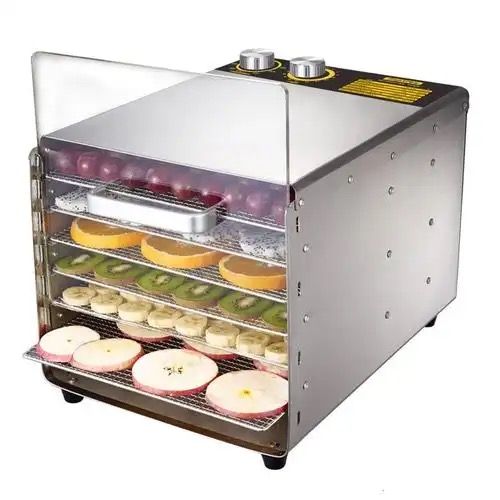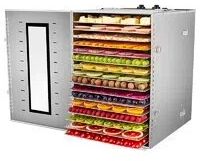
Content Menu
● Introduction
● Understanding Heat Pump Dryers
>> Key Components of Heat Pump Dryers
● Factors Affecting Electricity Consumption
>> 1. Ambient Temperature
>> 2. Humidity Levels
>> 3. Load Size
>> 4. Drying Time
>> 5. Type of Food
>> 6. Dryer Efficiency Rating
>> 7. Maintenance Practices
>> 8. Control Systems
>> 9. Insulation and Design
>> 10. Operational Practices
● Conclusion
● Frequently Asked Questions
>> 1. What is the average electricity consumption of a heat pump dryer?
>> 2. How can I reduce the electricity consumption of my heat pump dryer?
>> 3. Are heat pump dryers suitable for all types of food?
>> 4. What maintenance is required for heat pump dryers?
>> 5. Do heat pump dryers require special installation?
Introduction
In the modern food processing industry, energy efficiency is a critical concern, especially for manufacturers of food drying equipment. Heat pump dryers have emerged as a popular choice due to their ability to significantly reduce electricity consumption compared to traditional drying methods. This article explores the various factors that influence the electricity consumption of heat pump dryers, particularly in the context of food drying applications.

Understanding Heat Pump Dryers
Heat pump dryers operate on a principle similar to that of a refrigerator, using a refrigeration cycle to extract moisture from food products. They are designed to be energy-efficient, making them an ideal choice for food manufacturers looking to minimize operational costs. Unlike conventional dryers that expel hot air, heat pump dryers recycle the air within the system, which helps to conserve energy.
Key Components of Heat Pump Dryers
1. Evaporator: This component absorbs heat from the environment and evaporates the refrigerant, which cools the air inside the dryer.
2. Compressor: The compressor increases the pressure of the refrigerant, raising its temperature before it enters the condenser.
3. Condenser: In the condenser, the refrigerant releases heat, which is used to warm the air that is circulated through the drying chamber.
4. Expansion Valve: This valve regulates the flow of refrigerant into the evaporator, maintaining the efficiency of the system.
Factors Affecting Electricity Consumption
1. Ambient Temperature
The temperature of the environment where the heat pump dryer operates significantly impacts its electricity consumption. Heat pump dryers are most efficient in moderate temperatures. When the ambient temperature is too low, the dryer has to work harder to extract heat, leading to increased energy usage. Conversely, in warmer conditions, the dryer can operate more efficiently, reducing electricity consumption.
For instance, if a heat pump dryer is used in a cold storage facility, the energy required to maintain optimal drying conditions will be higher than in a warm, controlled environment. Manufacturers should consider the ambient temperature when planning their drying processes.
2. Humidity Levels
Humidity plays a crucial role in the drying process. Higher humidity levels mean that the dryer must remove more moisture from the air, which can increase electricity consumption. In contrast, lower humidity levels allow for faster drying times and reduced energy use.
For example, drying fruits in a humid environment may require longer drying times and more energy compared to drying the same fruits in a drier climate. Understanding the local climate and adjusting drying schedules accordingly can help optimize energy efficiency.
3. Load Size
The amount of food being dried in a single batch affects the energy efficiency of heat pump dryers. Overloading the dryer can lead to longer drying times and increased energy consumption, as the machine struggles to remove moisture from a larger volume of product. Conversely, underloading can also be inefficient, as the dryer may not operate at its optimal capacity.
Finding the right balance is essential for maximizing energy efficiency. For instance, if a dryer is rated for 100 kg of food, consistently loading it with 80 kg may lead to inefficient energy use, while loading it with 120 kg could result in inadequate drying.

4. Drying Time
The duration of the drying process directly correlates with electricity consumption. Longer drying times result in higher energy usage. Factors such as the type of food being dried, its moisture content, and the desired final moisture level all influence drying time.
For example, drying herbs may take significantly less time than drying thick slices of meat. By optimizing drying times based on the specific food product, manufacturers can reduce energy consumption and improve overall efficiency.
5. Type of Food
Different types of food require varying amounts of energy to dry. For instance, fruits and vegetables typically have higher moisture content than grains or nuts, necessitating longer drying times and more energy. Understanding the specific drying requirements of different food products can help manufacturers choose the right settings and reduce energy consumption.
Additionally, the preparation of food before drying can also impact energy use. Pre-cutting or blanching vegetables can reduce drying time and energy consumption, making the process more efficient.
6. Dryer Efficiency Rating
The efficiency rating of a heat pump dryer is a critical factor in its electricity consumption. Higher-rated models are designed to use less energy while providing the same drying performance. Investing in energy-efficient equipment can lead to significant savings in electricity costs over time.
When selecting a heat pump dryer, manufacturers should look for models with high energy efficiency ratings, such as those certified by ENERGY STAR. These models are designed to minimize energy consumption while maximizing performance.
7. Maintenance Practices
Regular maintenance of heat pump dryers is essential for optimal performance. Clogged filters, dirty coils, and other maintenance issues can lead to increased energy consumption. Implementing a routine maintenance schedule can help ensure that the dryer operates efficiently, minimizing electricity usage.
For example, cleaning the air filters regularly can improve airflow and reduce the workload on the dryer, leading to lower energy consumption. Additionally, checking for refrigerant leaks and ensuring that the compressor is functioning properly can also enhance efficiency.
8. Control Systems
Modern heat pump dryers often come equipped with advanced control systems that allow for precise monitoring and adjustment of drying parameters. These systems can optimize energy use by adjusting the drying process based on real-time data, such as moisture levels and ambient conditions. Utilizing these features can lead to significant reductions in electricity consumption.
For instance, some dryers have sensors that detect the moisture content of the food and adjust the drying time accordingly. This not only saves energy but also ensures that the food is dried to the desired level without over-drying.
9. Insulation and Design
The design and insulation of the dryer itself can impact its energy efficiency. Well-insulated dryers retain heat better, reducing the amount of energy required to maintain optimal drying temperatures. Manufacturers should consider the design and insulation of their equipment to enhance energy efficiency.
For example, a dryer with poor insulation may lose heat to the environment, requiring more energy to maintain the desired temperature. Investing in well-designed, insulated equipment can lead to long-term energy savings.
10. Operational Practices
The way in which a heat pump dryer is operated can also affect its electricity consumption. Training staff on best practices for loading, operating, and maintaining the dryer can lead to more efficient use of energy. Implementing standard operating procedures can help ensure that the dryer is used in the most energy-efficient manner possible.
For instance, staff should be trained to load the dryer properly, ensuring that air can circulate freely around the food. This can help reduce drying times and energy consumption.
Conclusion
Heat pump dryers offer a highly efficient solution for food drying, but their electricity consumption can vary based on several factors. By understanding and optimizing these factors—such as ambient temperature, humidity levels, load size, and maintenance practices—food manufacturers can significantly reduce their energy costs while maintaining high-quality drying processes. Investing in energy-efficient equipment and implementing best practices can lead to substantial savings and a more sustainable operation.

Frequently Asked Questions
1. What is the average electricity consumption of a heat pump dryer?
The average electricity consumption varies based on the model and usage, but heat pump dryers typically use 1 to 2 kWh per load.
2. How can I reduce the electricity consumption of my heat pump dryer?
Optimize load sizes, maintain the dryer regularly, and monitor ambient conditions to ensure efficient operation.
3. Are heat pump dryers suitable for all types of food?
Yes, heat pump dryers can be used for various food types, but drying times and energy consumption may vary based on moisture content.
4. What maintenance is required for heat pump dryers?
Regularly clean filters, check for blockages, and ensure that coils are clean to maintain efficiency.
5. Do heat pump dryers require special installation?
While they do not require venting, proper installation is essential for optimal performance, including adequate space for airflow.












